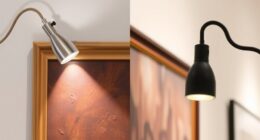To paint a ceiling without streaks, start by choosing quality angled brushes or ceiling rollers to guarantee smooth application. Maintain a consistent, slightly wet edge and use long, controlled strokes, avoiding pressure that causes marks. Stir your paint so it’s smooth and creamy, then load your tools properly without overloading. Work systematically in a pattern, blending edges for a flawless finish. Keep practicing these techniques, and you’ll master streak-free ceilings—more tips follow to perfect your work.
Key Takeaways
- Use high-quality angled brushes or ceiling rollers for smooth, even application.
- Maintain a wet edge by working in sections and blending strokes seamlessly.
- Stir paint thoroughly to achieve a creamy consistency and prevent drips or streaks.
- Apply paint with long, consistent strokes, avoiding pressure to prevent uneven lines.
- Allow the ceiling to dry completely, then lightly sand and touch up any uneven areas for a flawless finish.

Painting a ceiling without streaks can seem challenging, but with the right techniques, you can achieve a smooth, professional finish. The key lies in mastering your brush techniques and guaranteeing the paint consistency is just right. When you’re preparing to paint, start by selecting the appropriate brush—preferably a high-quality angled brush or a roller designed for ceilings. A good brush allows you to control your strokes better and minimizes streaks. Before you begin, dip your brush or roller lightly into the paint, and tap off any excess to avoid drips and pooling, which can cause uneven coverage and streaks.
Your brush techniques are essential for a streak-free finish. Use long, smooth strokes and maintain a wet edge as you work. This means you should always blend into the previously painted section before it dries. When you’re applying the paint, avoid pressing too hard with your brush; instead, let the brush do the work by gently feathering the paint across the surface. Keep your strokes consistent in direction—preferably in one direction or in a pattern that minimizes visible lines. When painting near the edges or corners, use the angled brush to get close without disturbing the main area. This precision helps prevent uneven patches and streaks.
Use long, smooth strokes and keep a wet edge for a streak-free ceiling finish.
Another critical aspect is paint consistency. You want your paint to be smooth and creamy—not too thick or runny. If it’s too thick, it’ll leave brush marks and streaks; if it’s too thin, it might drip and create uneven patches. To achieve the perfect consistency, stir the paint thoroughly and consider adding a small amount of water or paint conditioner if needed. Test it on a scrap piece or a hidden section of the ceiling to see how it flows. The paint should spread easily with no clumps or drips, creating a uniform coat. Additionally, proper lighting can help you spot uneven areas and streaks during the painting process.
As you work, keep your brush or roller loaded with enough paint, but avoid overloading it. Too much paint increases the chances of drips and streaks. Replenish your brush frequently to maintain even coverage. Remember to work systematically across the ceiling, overlapping each stroke slightly to blend seamlessly. Patience is fundamental—don’t rush the process. If streaks do appear, wait for the paint to dry, then lightly sand and touch up with a fresh coat, using the same brush techniques and consistent paint to guarantee a flawless finish. With practice and attention to detail, you’ll master the art of painting ceilings without streaks.
Frequently Asked Questions
What Type of Paint Is Best for Ceiling Painting?
For ceiling painting, you should choose a flat or matte paint finish, as it minimizes reflections and hides imperfections. Opt for a high-quality latex or acrylic paint with a low sheen to make certain of an even, streak-free look. Using the right paint type helps you achieve a smooth surface, preventing streaks and brush marks. Always select a paint formulated for ceilings to get the best coverage and durability.
How Do I Choose the Right Ceiling Paint Color?
You choose the right ceiling paint color by considering your ceiling’s texture and the paint sheen. Opt for lighter shades to make a room feel more spacious, especially if your ceiling has a textured surface. A flat or matte sheen helps hide imperfections and creates a smooth finish, while a satin or eggshell sheen adds subtle depth. Match the color to your overall room palette for a cohesive look.
Can I Use a Roller or Brush for Ceilings?
You can definitely use a roller or brush for ceilings. Many believe rollers are best, and that’s true if you choose the right roller selection—look for a high-density nap for smooth coverage. Use proper brush techniques for edges and corners, then switch to the roller for large areas. This combination minimizes streaks and guarantees an even coat. So, yes, both tools work, but your technique and roller choice matter most.
How Long Should I Wait Between Coats?
You should wait about 2 to 4 hours between coats, but always check the paint’s drying time on the label, as it varies with paint thickness and humidity. Rushing this step can cause streaks or uneven coverage. Confirm the first coat is dry to the touch before applying the next. Patience here results in a smooth, professional finish without streaks or smudges.
What Tools Help Prevent Streaks During Painting?
You can prevent streaks by using quality brushes and proper brush techniques, like long, smooth strokes and avoiding overloading the brush. Painter’s tape helps create clean edges and prevents paint from bleeding onto walls, reducing touch-ups that can cause streaks. Keep your tools in good condition, and work steadily to guarantee an even coat. These steps help you achieve a streak-free finish with minimal effort.
Conclusion
Now that you know how to paint a ceiling without streaks, you’re all set to achieve a flawless finish. Remember, using quality tools and proper techniques makes all the difference. Did you know that a well-painted ceiling can increase your home’s value by up to 10%? So, take your time, stay patient, and enjoy the process. With these tips, you’ll be proud of your smooth, professional-looking ceiling in no time!









